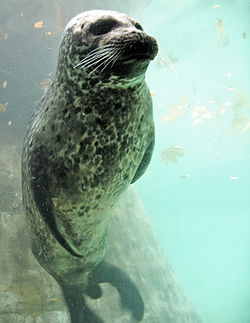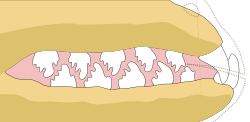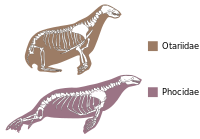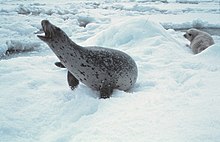Pinniped
| Pinnipeds Temporal range: Late Oligocene – Recent |
|
|---|---|
 |
|
| Harbor Seal (Phoca vitulina) | |
| Scientific classification | |
| Kingdom: | Animalia |
| Phylum: | Chordata |
| Subphylum: | Vertebrata |
| Class: | Mammalia |
| Order: | Carnivora |
| Suborder: | Caniformia |
| (unranked): | Pinnipedia Illiger, 1811 |
| Families | |
|
Odobenidae (walruses) |
|
Pinnipeds (from Latin pinna, wing or fin, and ped-, foot) or fin-footed mammals are a widely distributed and diverse group of semiaquatic marine mammals comprising the families Odobenidae (the walrus), Otariidae (eared seals, including sea lions and fur seals), and Phocidae (earless seals).
Contents |
[edit] Overview
| This section does not cite any references or sources. (April 2012) |
Pinnipeds are typically sleek-bodied and barrel-shaped. Their bodies are well adapted to the aquatic habitat where they spend most of their lives. Their limbs consist of short, wide, flat flippers. The smallest pinniped, the Baikal seal, weighs about 70 kg (155 lb) on average when full-grown and is 1.3 m (4 ft 3 in) long; the largest, the male southern elephant seal, is over 4 metres (13 ft) long and weighs up to 4,000 kilograms (8,800 lb).
[edit] Phocidae
Earless seals, also called true seals, or phocids, are the most diverse and widespread pinnipeds. They lack external ears, have more streamlined snouts, and are generally more aquatically adapted than otariids. They swim with efficient, undulating whole-body movements using their more-developed rear flippers. The swimming efficiency and an array of other physiological adaptations make them better built for deep and long diving and long distance migration. These mammals are, however, very clumsy on land, moving by wriggling their front flippers and abdominal muscles. The two back flippers form a tail-like structure which does not aid walking on land. True seals generally communicate by slapping the water and grunting rather than vocalising.
[edit] Otariidae
Eared seals, also called walking seals or otariids, include the animals commonly known as sea lions and fur seals. These vocal, social animals are somewhat better adapted to terrestrial habitats, with rear flippers that can turn forward so they can move on all fours on land. Their fore flippers are larger than those of earless seals and are used as a primary source of propulsion and maneuverability in the water. Eared seals have external ears, as their name suggests, and more dog-like snouts, further distinguishing them from true seals. While sea lions are generally larger than fur seals and lack the dense underfur of the latter, the long-standing division into subfamilies (Arctocephalinae and Otariinae for fur seals and sea lions, respectively) is unjustified in light of genetic evidence suggesting several fur seal species are more closely related to some sea lions than other fur seals. The iconic ball-balancing circus seal is generally some species of sea lion, most commonly a California sea lion.
[edit] Odobenidae

The walrus is an exclusively Arctic species—the sole surviving member of the once diverse and widespread Odobenidae family. They are easily recognized by their long tusks and great bulk of up to 2,000 kilograms (4,400 lb). While they share with otariids the ability to turn their rear flippers forward, their swimming is more reminiscent of that of true seals, relying more on sinuous whole body movements. They also lack external ears. Unlike eared seals and true seals, which feed primarily by hunting fish and squid in the water column, walrus generally prefer clams and other invertebrates living on the ocean floor. The unique squirt and suck method of feeding on mollusks first differentiated the original walrus ancestor from other pinniped lineages. There remains debate as to whether the walrus diverged from the eared seals before or after the true seals.
[edit] Anatomy
[edit] Flippers

Pinniped limbs, or flippers, are proportionally shorter than those of most other mammals. Because the density of water is much higher than that of air, pinniped flippers can also be proportionally much smaller than the wings of birds or bats, relative to total body size. The digits of each limb are bound together by a web of skin (fingers and toes), and have claws on either their front flippers (earless seals), or their back flippers (eared seals).
[edit] Skin/coat/molting
| This section does not cite any references or sources. (June 2011) |
Fur seals have both blubber and a specially adapted fur coat, including outer guard hairs that repel water and a layer of insulating underfur. For this reason they were particularly prized by sealers. Many species were nearly hunted to extinction.
For most pinniped species, molting is an annual process of replacing worn fur (and in some cases, skin) that temporarily grounds them. Molting can compromise thermoregulation, so some species, such as elephant seals, fast and remain onshore for a month or more.
In many species, pups are born with a natal coat of a different length, texture and/or color than adults. This coat is adapted for the terrestrial, preweaning period, either a thick pelage to keep them warm in arctic environments, or a thin layer of fur to keep them cool on summer sands. During their first molt (about 11 days after birth for harp seals), the pups replace this with an adult coat better suited to life at sea. Until this age, pups risk hypothermia and drowning if they spend too much time in the ocean.
[edit] Thermoregulation
| This section does not cite any references or sources. (June 2011) |
Pinnipeds use several strategies to conserve body heat while foraging in cold waters. Most primarily rely on a thick layer of blubber (fat) under their skin, which also provides buoyancy, hydrodynamic shape, and stores energy. Some young seals have a thick fur coat as well as blubber. Additionally, the pinniped circulatory system is uniquely adapted to redirect blood away from body surface areas to prevent heat loss.
Pinnipeds living in warmer climes, such as Galapagos or Australian sea lions, must keep cool when they haul out onto land to rest, breed, and nurse their pups. Strategies include resting in the shade or in tide pools, or covering themselves in a thin layer of sand ("sand-flipping"). They can also shunt blood to the surface of their flippers for rapid cooling by waving or dipping in pools.

[edit] Pulmonary surfactant
When the surfactant systems of different pinnipeds are analyzed and compared to terrestrial mammals, pinnipeds show different surfactant composition and secretion, probable adaptations for an efficient surfactant system to deal with the pressures of collapsing lungs. Pinnipeds have unique lungs with airways highly reinforced with cartilage and smooth muscle, and alveoli that completely collapse during deeper dives.[1] While overemptying of the lungs in humans classifies as a lung disease and terrestrial mammals are in general unable to empty their lungs,[2] pinnipeds are able to reinflate their lungs even after complete respiratory collapse.[3] Thus, surfactant as an antiadhesive in the regular collapse and reopening of alveoli may be the primary function of the system in pinnipeds. The hydrostatic pressure pinnipeds experience during diving is hypothesized to have acted as an external selection force during evolution for adaptations in their pulmonary surfactant system to meet the challenges of extreme hydrostatic pressure and regularly collapsing lungs.[2][4][5][6] It has been argued that a surfactant complex that functions as an antiadhesive needs to be fluid and highly spreadable.[2]
[edit] Surfactant composition
When compared to terrestrial mammals (cattle, sheep, pigs, humans), California sea lions (Zalophus californianus), northern elephant seals (Mirounga angusturistris), ringed seals (Phoca hispida), and harbor seals (Phoca vitulina) have lower levels of anionic surfactant phospholipids [phosphatidyldlycerol (PG) and phosphatidylinositol (PI)].[2][4][7] Although the role of PG and PI are not clear, they appear to interact with hydrophobic surfactant proteins SP‐B and SP‐C to prevent the irreversible removal of the phospholipids from the surfactant film during alveolar compression and collapse for rapid reinsertion upon re-expansion.[2][4][7] There is also a greater percentage of short fatty acid phosphatidylcholine, the primary phospholipid contributor to surfactant function, in pinnipeds than in terrestrial mammals.[2] Since fluidity of the surfactant mixture is also dependent on fatty acid tail length where length leads to increased surfactant fluidity, the change in tail length may indicate a surfactant system adaptation in response to the selection for an effective antiadhesive surfactant in collapsed lungs of diving pinnipeds.
[edit] Surfactant secretion
There is also environmental pressure for a pulmonary surfactant system capable of controlled surfactant secretion even under long periods of hydrostatic pressure.[8][9] Alveolar epithelial type II cells, which secrete surfactant when stretched, appear to have decreased sensitivity to pressure in California sea lions compared to terrestrial mammals so that constant levels of surfactant are maintained under long periods of pressure.[8] Furthermore, the gene for leptin, a hormone that has a role in surfactant phospholipid synthesis, was found to have nonsynonymous substitutions that are under positive selection in phocids within otherwise highly conserved regions in mammals.[10] The sites of substitution are predicted to be on the exposed sides of leptin, where the changes likely alter leptin function.[11] The modified leptin can then affect surfactant production in phocids.
[edit] Other adaptations
Pinniped eyes are well adapted for seeing both above and below the water surface. The animal has a clear membrane that covers and protects its eyes underwater. In addition, its nostrils close and blood circulation stops to most of its organs when diving. Testicles and mammary glands are located in slits under the skin to maintain the pinniped’s streamlined shape. They also have whiskers to help navigate, and sensors in their skull to absorb sounds underwater and transmit them to the cochlea.
[edit] Life history
[edit] Reproduction
Males of some species, including elephant seals, South American sea lions, and northern fur seals, aggressively defend groups of specific females, referred to as harems. Males of other species, including most sea lions and brown fur seals, defend territories on reproductive rookeries while females move freely between them. Occasionally, violent competition for females or territories is an integral part of male breeding strategy among most pinnipeds. Otariids, which are generally more land-adapted, form major aggregations in the summer months on beaches or rocky outcrops. Consequently, their reproductive behavior is easier to observe and relatively well-studied. Walruses and many phocids, on the other hand, form smaller aggregations, often in remote locations or on ice, and copulate in the water. Their reproductive behavior is less well known.
Females have a postpartum estrus that allows them to mate soon after giving birth. Delayed embryo implantation (embryonic diapause) obviates the need to come ashore (haul out) to twice a year, once to give birth and again to mate. After giving birth, mothers suckle their young for a variable period. Phocid lactation varies from four to 50 days, whereas otarids lactate from four to 36 months. This reflects the fact that phocid feeding grounds tend to be far off shore, so lactation is associated with maternal fasting. To compensate for the short lactation period, the fat content of phocid milk (45–60% fat) is higher than in any other marine mammal species. After lactation, most females migrate to feeding grounds for intensive foraging to recoup energy reserves. Otariid feeding grounds are generally closer to shore and mothers take foraging trips. Otariid milk fat content is lower than that of phocids, owing to the protracted lactation period (typically 25–50%). Protracted nursing also leads to the formation of social bonds.
After the female returns from her first feeding trip, the most important task for her is to find her own pup out of the mass of other pups. Feeding a different mother's pup is a significant waste of energy, as milk production has a high parental cost. The seal overcomes this complication by voice recognition. The mother and pup must learn each other's voices in the first few days after the pup is born, before the dam goes on her next hunt. On returning, the mother seal calls out to her pup, causing the pup to call back. This enables the mother to find her own pup and not waste any energy feeding and taking care of the wrong pup, as this would only decrease her own fitness.[12]
[edit] Diving
Pinnipeds can hold their breath for nearly two hours underwater by conserving oxygen.[13] When the animal starts diving, its heart rate slows to about one-tenth of its normal rate. The arteries squeeze shut and the sense organs and nervous system are the only organs to receive normal blood flow. They are able to resist more pain and fatigue caused by lactic acid accumulation than other mammals. However, once they return to the surface, they need time to recover and normalize their body chemistry.[14]
[edit] Sleep
Pinnipeds spend many months at a time at sea and so they must sleep in the water. Scientists have recorded them sleeping for minutes at a time while slowing drifting downward belly up.
[edit] Ecology
[edit] Diet

Pinnipeds are carnivorous, eating fish, shellfish, squid, penguins, and other marine creatures. Most are generalist feeders, but some specialize. For example, Ross seals and southern elephant seals mainly feed on squid. Crabeater seals eat mostly krill, and ringed seals almost exclusively consume crustaceans. The walrus consumes its molluscan prey by sucking the soft parts from the shell.
Some seals eat warm-blooded prey, including other seals. The leopard seal, which is probably the most carnivorous and predatory pinniped, eats penguins as well as crabeater and Ross seals. The South American sea lion also eats penguins, flying seabirds and young South American fur seals. Steller sea lions eat northern fur seal pups, common seal pups, and birds.
[edit] Predation
Almost all pinnipeds are potential prey for orcas and larger sharks. Arctic species are an important component of polar bear diets. Antarctic seals, however, are not preyed upon by terrestial predators, unlike seals in the Arctic.
[edit] Survival
As the Arctic ice pack diminishes due to global warming, more species of pinnipeds are hauling out on the shores. Walrus and spotted seals on the coasts of the U.S., Canada and Russia, show increasing signs of an often-fatal, mystery disease of unknown etiology. Harp seals in Greenland may be similarly affected.[15]
The Caribbean monk seal was declared extinct in 2008.
[edit] Taxonomy
Formerly classified as a separate biological suborder, Pinnipedia is now considered a subgroup within the suborder Caniformia of the order Carnivora.[citation needed]

Above: Phylogeny determined from parsimony analysis of 50 maximum likelihood gene trees[16]

- Family Odobenidae
- Walrus, Odobenus rosmarus
- Imagotaria downsi (extinct)
- Family Otariidae
- Genus Arctocephalus
- Antarctic Fur Seal, A. gazella
- Guadalupe Fur Seal, A. townsendi
- Juan Fernández Fur Seal, A. philippii
- Galápagos Fur Seal, A. galapagoensis
- Brown Fur Seal, A. pusillus
- South African Fur Seal, A. pusillus pusillus
- Australian Fur Seal, A. pusillus doriferus
- Australasian Fur Seal, A. forsteri
- Subantarctic Fur Seal, A. tropicalis
- South American Fur Seal, A. australis
- Genus Callorhinus
- Northern Fur Seal, C. ursinus
- Genus Eumetopias
- Steller Sea Lion, E. jubatus
- Genus Neophoca
- Australian Sea Lion, N. cinerea
- Genus Otaria
- South American Sea Lion, O. flavescens
- Genus Phocarctos
- New Zealand Sea Lion, P. hookeri
- Genus Zalophus
- California Sea Lion, Z. californianus
- Japanese Sea Lion, Z. japonicus – extinct (1950s)
- Galápagos Sea Lion, Z. wollebaeki
- Genus Arctocephalus
- Family Phocidae
- Subfamily Monachinae
- Tribe Monachini
- Monachopsis (extinct)
- Pristiphoca (extinct)
- Properiptychus (extinct)
- Messiphoca (extinct)
- Mesotaria (extinct)
- Callophoca (extinct)
- Pliophoca (extinct)
- Pontophoca (extinct)
- Hawaiian Monk Seal, Monachus schauinslandi
- Mediterranean Monk Seal, Monachus monachus
- Caribbean Monk Seal, Monachus tropicalis (probably extinct around 1950)
- Tribe Miroungini
- Northern Elephant Seal, Mirounga angustirostris
- Southern Elephant Seal, Mirounga leonina
- Tribe Lobodontini
- Monotherium wymani (extinct)
- Ross Seal, Ommatophoca rossi
- Crabeater Seal, Lobodon carcinophagus
- Leopard Seal, Hydrurga leptonyx
- Weddell Seal, Leptonychotes weddellii
- Swan-necked Seal, Acrophoca longirostris (extinct)
- Piscophoca pacifica (extinct)
- Homiphoca capensis (extinct)
- Tribe Monachini
- Subfamily Phocinae
- Kawas benegasorum (extinct)
- Leptophoca lenis (extinct)
- Preapusa (extinct)
- Cryptophoca (extinct)
- Bearded Seal, Erignathus barbatus
- Hooded Seal, Cystophora cristata
- Tribe Phocini
- Common Seal or Harbor Seal, Phoca vitulina
- Spotted Seal or Larga Seal, Phoca largha
- Ringed Seal, Pusa hispida (formerly Phoca hispida)
- Baikal Seal or Nerpa, Pusa sibirica (formerly Phoca sibirica)
- Caspian Seal, Pusa caspica (formerly Phoca caspica)
- Harp Seal, Pagophilus groenlandica (formerly Phoca groenlandicus)
- Ribbon Seal, Histriophoca fasciata (formerly Phoca fasciata)
- Phocanella (extinct)
- Platyphoca (extinct)
- Gryphoca (extinct)
- Gray Seal, Halichoerus grypus
- Subfamily Monachinae
[edit] Evolution
Recent molecular evidence suggests that pinnipeds evolved from a bearlike ancestor about 23 million years ago during the late Oligocene or early Miocene epochs, a transitional period between the warmer Paleogene and cooler Neogene period.[17] The earliest fossil pinniped that has been found is Puijila darwini, of about 23 million years ago. Pujilla had heavy limbs, indicative of upright movement on land, and flattened phalanges, indicating they were probably webbed, but not yet flippers. The discovery of Pujilla in northern Canada strongly suggests pinnipeds originated in the Arctic. The reference to Charles Darwin is in honor of his contention made in On the Origin of Species (1859) that
A strictly terrestrial animal, by occasionally hunting for food in shallow water, then in streams or lakes, might at last be converted in an animal so thoroughly aquatic as to brace the open ocean[18]
The otter-like mustelid Potamotherium may actually represent an even earlier phase in the evolution of pinnipeds.[19]
Another (more advanced) early pinniped is Enaliarctos, which lived 24 – 22 million years ago. It is believed to have been a good swimmer, but to have been able to move on land as well as in water, more like an otter than like modern pinnipeds. There has been longstanding debate as to whether walruses diverged from a common otariid-phocid ancestor, or whether the phocids diverged before a common otariid-odobenid ancestor. The most recent evidence suggest the latter hypothesis is more likely.[20]
[edit] Orkney folklore
The folklore of Orkney includes tales of the selkie folk ("selkie" being the Orcadian dialect word for "seal"), a race of shape-shifting seals that can take human form. To do so they have to remove their seal skin, revealing what appears to be a human underneath. They would also venture onto land for encounters with human women, often unsatisfied ones.[21]
[edit] See also
- Ambulocetus
- Cetacea
- Nothosaur
- Pinnipeds in popular culture
- Seal hunting
- Sirenia
- Tagging of Pacific Predators
- Vocal learning
[edit] References
- ^ Kooyman, G. L.; Castellini, M. A.; Davis, R. W. (1981). "Physiology of diving in marine mammals". Annual Review of Physiology 43: 343–356. doi:10.1146/annurev.ph.43.030181.002015.
- ^ a b c d e f Miller, N. J.; Postle, A. D.; Orgeig, S.; Koster, G.; Daniels, C. B. (2006b). "The composition of pulmonary surfactant from diving mammals". Respiratory Physiology & Neurobiology 152 (2): 152–168. doi:10.1016/j.resp.2005.08.001.
- ^ Denison, D. M.; Kooyman, G. L. (1973). "Structure and function of small airways in pinniped and sea otter lungs". Respiration Physiology 17 (1): 1–10. doi:10.1016/0034-5687(73)90105-9.
- ^ a b c Foot, N. J.; Orgeig, S.; Daniels, C. B. (2006). "The evolution of a physiological system: The pulmonary surfactant system in diving mammals". Respiratory Physiology & Neurobiology 154 (1–2): 118–138. doi:10.1016/j.resp.2006.04.012.
- ^ Maina, J. N.; West, J. B.; Orgeig, S.; Foot, N. J.; Daniels, C. B.; Kiama, S. G.; Gehr, P.; et al. (2010). "Recent advances into understanding some aspects of the structure and function of mammalian and avian lungs". Physiological and Biochemical Zoology 83 (5): 792–807. doi:10.1086/652244.
- ^ Miller, N. J.; Daniels, C. B.; Schurch, S.; Schoel, W. M.; Orgeig, S. (2006a). "The surface activity of pulmonary surfactant from diving mammals". Respiratory Physiology & Neurobiology 150 (2–3): 220–232. doi:10.1016/j.resp.2005.03.002.
- ^ a b Spragg, R. G.; Ponganis, P. J.; Marsh, J. J.; Rau, G. A.; Bernhard, W. (2004). "Surfactant from diving aquatic mammals". Journal of Applied Physiology 96 (5): 1626–1632. doi:10.1152/japplphysiol.00898.2003. http://jap.physiology.org/content/96/5/1626.full.
- ^ a b Miller, N. J.; Daniels, C. B.; Costa, D. P.; Orgeig, S. (2003). "Coping with pressure: surfacatant secretion from pinniped alveolar type II cells at depth". Comparative Biochemistry and Physiology a‐Molecular & Integrative Physiology 134: S1–S128.
- ^ Miller, N. J.; Daniels, C. B.; Costa, D. P.; Orgeig, S. (2004). "Control of pulmonary surfactant secretion in adult California sea lions". Biochemical and Biophysical Research Communications 313 (3): 727–732. doi:10.1016/j.bbrc.2003.12.012.
- ^ Hammond, J. A.; Bennett, K. A.; Walton, M. J.; Hall, A. J. (2005). "Molecular cloning and expression of leptin in gray and harbor seal blubber, bone marrow, and lung and its potential role in marine mammal respiratory physiology". American Journal of Physiology: Regulatory Integrative and Comparative Physiology 289 (2): R545–R553. doi:10.1152/ajpregu.00203.2004. http://ajpregu.physiology.org/content/289/2/R545.full.
- ^ Torday, J. S.; Powell, F. L.; Farmer, C. G.; Orgeig, S.; Nielsen, H. C.; Hall, A. J. (2010). "Leptin integrates vertebrate evolution: From oxygen to the blood‐gas barrier". Respiratory Physiology & Neurobiology 173 (Suppl.): S37–S42. doi:10.1016/j.resp.2010.01.007.
- ^ Charrier et al. (2001)
- ^ Pinniped Seal
- ^ Encarta article on Seals
- ^ "Walruses hauling out in Northwestern Alaska with festering illness, too"Alaska Dispatch, 13 October 2011
- ^ Jeff W Higdon, Olaf RP Bininda-Emonds, Robin MD Beck, and Steven H Ferguson (2007). "Phylogeny and divergence of the pinnipeds (Carnivora: Mammalia) assessed using a multigene dataset". BMC Evol Biol. 2007 7: 216. doi:10.1186/1471-2148-7-216. PMC 2245807. PMID 17996107. //www.pubmedcentral.nih.gov/articlerender.fcgi?tool=pmcentrez&artid=2245807.
- ^ John J. Flynn et al.; 2 (2005). "Molecular Phylogeny of the Carnivora". Systematic Biology 54 (2): 317–337. doi:10.1080/10635150590923326. PMID 16012099. http://www.ingentaconnect.com/content/tandf/usyb/2005/00000054/00000002/art00010.
- ^ "'Missing link' fossil seal walked", BBC News, 22 April 2009
- ^ Rybczynski, N., Dawson, M.R & Tedford, R.H. (2009): A semiaquatic Arctic mammalian carnivore from the Miocene epoch and origin of Pinnipedia. Nature no 458, pp 1021–1024. Full text
- ^ Ulfur Arnason , Anette Gullberg, Axel Janke, et al. (2006). "Pinniped phylogeny and a new hypothesis for their origin and dispersal". Molecular Phylogenetics and Evolution 41 (2): 345–354. doi:10.1016/j.ympev.2006.05.022. PMID 16815048.1
- ^ orkneyjar.com
[edit] External links
| Look up pinniped in Wiktionary, the free dictionary. |
| Wikimedia Commons has media related to: Pinnipedia |


